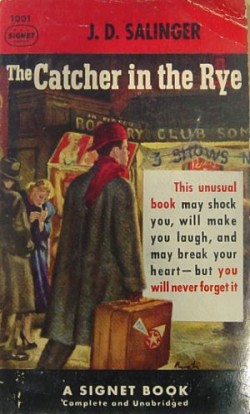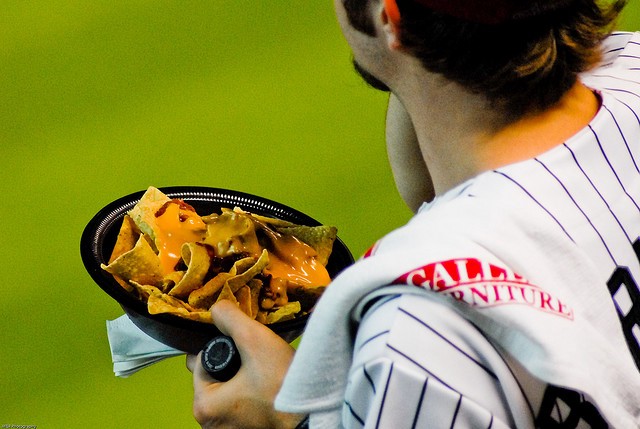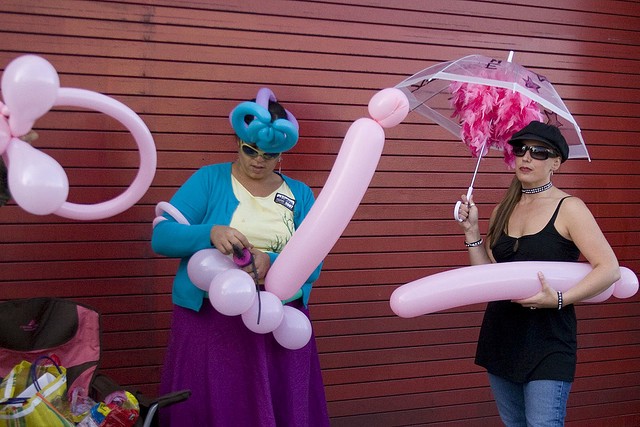Savage Britons Now Wiping Their Filthy Mouths On Paper Towels, Knives
“The napkin, once a staple of the British dinner table, is being replaced by kitchen roll as evening meals become a more informal affair, a survey has found.”
Before 'Catcher In The Rye': J.D. Salinger's First Holden Caulfield Stories
by Michael Moats

Tomorrow marks the 60th anniversary of the publication of J.D. Salinger’s The Catcher In The Rye. This excerpt is from a longer essay, “The Real Holden Caulfield,” available at the Fiction Advocate.
It was either dumb luck or artistic excess that led Salinger to give his most sentimental and developmentally arrested character the name “Holden.” Salinger jammed his foot into the trap set by that name, and only managed to walk away because, as with everything about Holden, there is an authenticity that insulates him and his author from the annual term paper analyses that he is “holdin’ on to his innocence” or “holdin’ back his emotions.” According to one story, Salinger was walking through Manhattan some unassuming day in 1947 when he came across the marquee for the movie Dear Ruth, starring William Holden and Joan Caulfield. Side-by-side in marquee letters (in lights, as it were) were the words ‘Holden’ and ‘Caulfield.’ Another story carries over the Joan Caulfield connection, but instead claims that ‘Holden’ came from one of Salinger’s shipmates during his time as part of the entertainment crew on a cruise ship. The plot thickened in 2001 when Denver’s Rocky Mountain News printed the obituary of a man named Holden Bowler, an Idaho-born singer, ad man, 1932 U.S. Olympic athlete, and, in 1941, shipmate to J.D. Salinger on the cruise liner SS Kungsholm. According to Bowler’s widow, “Jerry told him, ‘What you like about Holden is taken from you, and what you don’t like about him, I made up.’” Salinger took no action to confirm or deny the story, nor did he ever comment on speculation that ‘Caulfield’ was pulled from Joan Caulfield.¹ Salinger’s daughter Margaret wrote that her father often complained about “giving his beloved characters ‘terrible’…names, such as Seymour, but that’s just what Seymour’s parents would have done, he said, so he had to do it even though it ‘nearly killed him.’”² So it simply may be that Mr. and Mrs. Caulfield are responsible. It may also be worth noting that the hero of David Copperfield, referred to by Holden in the opening sentences of The Catcher in the Rye, divulges in his own opening chapter that he was born with a caul. So perhaps there is some David Copperfield kind of crap in Holden’s story after all.
It’s unlikely that any of these stories gets it exactly right. Salinger began working on Holden Caulfield more than ten years before The Catcher in the Rye, which was six years before he might have come across Dear Ruth at the local cinema and at least five years ahead of Joan Caulfield’s film debut. (She did have a modeling and Broadway career before going to Hollywood, but she didn’t reach the stage until 1943. Chances are slim that Salinger would have caught her name on any marquee, or known much about her in his Kungsholm days.) The most likely of the possibilities, that Holden was named after the author’s 1941 shipmate, would mean that Salinger must have settled on the name not long before Holden’s first story, “Slight Rebellion Off Madison,” was accepted by The New Yorker later that same year.
As of 1941 there is no Allie, no Jane Gallagher and no Phoebe. There is just Holden Caulfield: an upper-middle class teenager who begins railing against the things he hates.
“Slight Rebellion” is an early, third person rendering of Holden’s date with Sally Hayes in The Catcher in the Rye. There are slight variations — Holden is home for Christmas break rather than expelled, and he and Sally spend some time dancing — but the core of the action is the same. Holden and Sally see a matinee where they “vehemently agreed with each other that the Lunts were marvelous.” They horse around in a cab. Sally tells Holden that she loves him and that crew cuts are corny. Sally’s ankles, as always, bend in awkwardly when she ice skates, and Holden is, as always, not much better. There are no hints in “Slight Rebellion” of just how much “madman stuff” Holden would get into. As of 1941 there is no Allie, no Jane Gallagher and no Phoebe. There is just Holden Caulfield: an upper-middle class teenager who begins railing against the things he hates. “I hate the Seventy-second Street movie, with those fake clouds on the ceiling, and being introduced to guys like George Harrison, and going down in elevators when you wanna go out, and guys fitting your pants all the time at Brooks.” Holden asks Sally to run away with him to the woods in Vermont or Maine. When she refuses, he leaves her at the skating rink.
The New Yorker picked up “Slight Rebellion” in November 1941 and planned to publish it to coincide with the Christmas season. The magazine was apparently intent on ruining the holidays for young readers everywhere. On December 7th, Japanese bombers attacked Pearl Harbor, drawing America into the Second World War. The next day President Roosevelt delivered his war message to Congress. New Yorker editors felt it would be poor form to publish a story about a troubled young man at a time when so many boys Holden’s age would soon be sent to the front lines. Salinger himself attempted to join the service in 1941, but was turned away because of a minor heart irregularity (no pun intended by the armed forces, I’m sure).³ This was a time for Roosevelt’s “unbounding determination of our people” and not Holden’s mopey, unguided hatred of waiting on the bus or getting fitted at Brooks. “Slight Rebellion Off Madison” was put on indefinite hold.
Salinger was undoubtedly disappointed but remained undaunted, and continued to develop Holden Caulfield in fits and starts over the next ten years. Holden shows up in two unpublished stories written in 1942, “Holden on the Bus,” and “The Last and Best of the Peter Pans.” A reference to the former exists in the “kill files” of rejected stories from The New Yorker, though no public record of the story exists today. In “The Last and Best of the Peter Pans,” Holden remains in the background of the story, which began to shape the Caulfield family that would eventually grow into The Catcher in the Rye. Vincent Caulfield, the narrator of “Peter Pans” is the oldest of the Caulfield children and the model for D.B. in Catcher. Kenneth, a younger brother who dies unexpectedly, would become Allie. Also appearing for the first time was Phoebe Caulfield. Holden, however, is mentioned only once. Today “The Last and Best of the Peter Pans,” which is in the Princeton Library and on publication embargo until 75 years after the author’s death, carries a sort of folklorish quality because it contains the first known mention of Salinger writing about a child needing to be saved as it moved towards a cliff.
In 1944 Holden made a substantial, though offstage, public appearance in “The Last Day of the Last Furlough,” printed in The Saturday Evening Post. The story is about “TECHNICAL SERGEANT John F. Gladwaller, Jr.” also known as “Babe,” and his last hours home before departing for World War II. The 1944 Babe Gladwaller (God only knows where Salinger got this name) seems like a revision of the Holden Caulfield deemed unfit for public consumption in “Slight Rebellion Off Madison.” Babe’s angst is more understandably focused on the things he loves and hates to leave behind: his books, his snow-covered neighborhood, his younger sister Mattie. Holden sulks over “fitting your pants all the time at Brooks,” while Babe is morose and introspective about going to war to defend these things, cataloging the inevitable search that likely engages every soldier on the eve of shipping out, the questions of why we go to war at all.
What protects “Last Furlough” from melodrama is the presence of Babe’s Army buddy, Vincent Caulfield. Vincent has “a kid brother in the Army who flunked out of a lot of schools. He talks about him a lot. Always pretending to pass him off as a nutty kid.” While Babe anticipates fear and loss, Vincent’s got the real thing: his brother Holden has gone missing in the Pacific. This, then, was the first published mention of Holden Caulfield. He is 20 years old, nine years younger than Vincent and — somehow — taught biology before enlisting in the army. But the Holden of Catcher is there, as Vincent tells Babe:
“I used to bump into him at the old Joe College Club on Eighteenth and Third in New York. A beer joint for college kids and prep school kids. I’d go there just looking for him, Christmas and Easter vacations when he was home. I’d drag my date through the joint, looking for him, and I’d find him way in the back. The noisiest, tightest kid in the place. He’d be drinking Scotch and every other kid in the place would be sticking to beer. I’d say to him, ‘Are you okay, you moron? Do you wanna go home? Do you need any dough?’ And he’d say, ‘Naaa. Not me. Not me, Vince. Hiya boy. Hiya. Who’s the babe’ And I’d leave him there, but I’d worry about him because I remembered all the crazy, lost summertimes when the nut used to leave his trunks in a wet lump at the foot of the staircase instead of putting them on the line. I used to pick them up because he was me all over again.”
In May 1944, two months before the publication of “Last Day of the Last Furlough,” Salinger wrote a letter to his mentor, Whit Burnett, the editor of Story magazine, saying that he had about six Holden Caulfield stories on hand. What happened to them is unknown. Holden continued to appear in pieces between 1944 and 1946, but mostly through the eyes of his brother Vincent. He showed up, through a letter and briefly in person, in “The Ocean Full of Bowling Balls,” an unpublished story from 1945. “Bowling Balls” is Vincent’s recollection of the last day of Kenneth Caulfield. Kenneth, like Allie, was a lover of baseball and poetry and wrote his favorite lines on his glove. His red hair could be spotted from across a golf course. And like Allie, he was frail, diagnosed with medical issues related to his heart. In the story, Kenneth dies after being struck by a wave while coming in from a swim. Holden is waiting on the porch, returned from camp and still holding his suitcases when Vincent returns home frantically seeking help for Kenneth. Kenneth dies later that night. “Bowling Balls” takes place on Cape Cod, while in Catcher Allie “got leukemia and died when we were up in Maine, on July 18, 1946.”
Holden next appeared in “This Sandwich Has No Mayonnaise,” from the October 1945 Esquire. The piece again follows Vincent, who is in Army training in Georgia, sitting in an overfilled troop transport, awaiting departure to a local dance hall. Through the din of the soldiers around him, Vincent reminisces and worries about his brother Holden, who, “can’t do anything but listen hectically to the maladjusted little apparatus he wears for a heart. My missing-in-action brother.”
The voice Salinger would eventually use to bring Holden to life is still developing at these early stages. There are far fewer curse words (Collier’s probably wouldn’t have stood for much more), and the word “slobs” appears where “phonies” would be later.
In December of the same year, Salinger published the story “I’m Crazy” in Collier’s. It was the first time readers heard directly from Holden Caulfield, and would later become the opening chapters of The Catcher in the Rye. “I’m Crazy” begins with Holden on the hill, looking for a proper goodbye from “Pentney Prep” (later “Pencey”) and describes the conversation with his history teacher, old Spencer. The voice Salinger would eventually use to bring Holden to life is still developing at these early stages. There are far fewer curse words (Collier’s probably wouldn’t have stood for much more), and the word “slobs” appears where “phonies” would be later. After the lecture from Spencer, the story jumps ahead to Holden’s return home that night. He wakes up Phoebe and plays with his infant sister Viola, who, it seems, would make this single appearance and disappear forever. In their conversation, Holden and Phoebe walk right up to the “catcher in the rye” vision, but stop short. When Holden’s parents come home, rather than venturing back into the night, Holden enters the living room to tell them he’s back, failed out of another school. The story closes with Holden facing a more clearly outlined and dismal fate than Catcher:
I lay awake for a pretty long time, feeling lousy. I knew everybody was right and I was wrong. I knew that I wasn’t going to be one of those successful guys, that I was never going to be like Edward Gonzales or Theodore Fisher or Lawrence Meyer. I knew that this time when Father said that I was going to work in that man’s office that he meant it, that I wasn’t going back to school again ever, that I wouldn’t like working in an office. I started wondering again where the ducks in Central Park went when the lagoon was frozen over, and finally I went to sleep.
The New Yorker finally published “Slight Rebellion Off Madison” in 1946. That same year, Salinger submitted a 90-page manuscript about Holden Caulfield to the magazine. It was accepted for publication, but strangely and suddenly withdrawn by the author. Over the course of the next five years Salinger would publish his most famous early works. His earliest and most cryptic Glass family story, “A Perfect Day for Bananafish,” appeared in 1948, followed by the string of pieces that would be collected in Nine Stories. In 1950, Samuel Goldwyn firmly established Salinger’s career by releasing My Foolish Heart, a Hollywood adaptation of “Uncle Wiggly in Connecticut” starring Dana Andrews and Susan Hayward. The title of the film, and its accompanying movie poster, which depicts Hayward and Andrews in passionate and orchestra-swelling embrace, were enough to prove that Hollywood got it all wrong. But Salinger’s embarrassment over My Foolish Heart was offset by the publication of one of his most moving and critically acclaimed stories, “For Esmé — with Love and Squalor,” in April of the same year. On July 14, 1951, two days before Catcher hit shelves, The New Yorker printed “Pretty Mouth and My Green Eyes.” Between “Slight Rebellion” and “Pretty Mouth,” Salinger’s career had exploded, making him not only a respected writer, but also a famous one. The straightforward angst of characters like Babe Gladwaller had been replaced by the searing and shaky breakdown of Sergeant X, and the chilling suicide of Seymour Glass. It had been five years since any member of the Caulfield family had been featured in a printed story. As far as anyone knew, Holden Caulfield was dead and gone.
¹ Ian Hamilton’s In Search of J.D. Salinger, page 39
² Margaret A. Salinger’s Dream Catcher: A Memoir , page 27
³ The Army soon lowered its medical standards for service and Salinger reported for duty on April 27, 1942 at Fort Dix, New Jersey.
Michael Moats completed his graduate thesis, a collection of essays on J.D. Salinger, and received his MFA from Emerson College in Boston. He recently reviewed J.D. Salinger: A Life by Kenneth Slawenski for AGNI Online. He blogs at Trade Paperbacks.
Snacking About Baseball: Foodstuffs Of The Major League Parks

David Raposa is off this week, but Yakkin’ About Baseball will return in its usual format next Friday. In the meantime, I’m offering an exclusive (if admittedly a bit self-promoting) look at a pet project of mine that’s snowballed into something of an obsession. For the past seven years, I’ve been working on a still-untitled book project that has entailed visiting — and eating at — every Major League ballpark. The idea was to provide an overview of the concessions (culinary, ethical, otherwise) of Our American Pastime, but it has become something else entirely.
What was originally intended as a mass-market coffee table book has become something much more ambitious — a cross between a Bleacher Report underboob slideshow, Henry Roth’s “Mercy of a Rude Stream,” that $600 compendium on molecular gastronomy with the 26-step recipes for veal-jowl “bullets” that start “harvest your agar-agar around 7 a.m.,” and some of the darker and more opaque volumes of the Old Testament. It’s no exaggeration for me to say that this project has basically ruined my life and made it impossible for me to have normal relationships. Here’s a taste!
New Yankee Stadium, New York
Aesthetically, New Yankee Stadium is not exceptional. The old stadium felt like a tourist-thronged temple, albeit one to which the Steinbrenners affixed some vinyl siding back in the ’70s. The new one looks and feels like a stadium-sized, extra-marble version of a Trump Tower bathroom, with a baseball diamond where the gold-plated bidet would be. But for stadium food, the New Yankee Stadium is exceptional indeed.
A menacing checkpoint ensures that fans with tickets to the stadium’s upper and Pinstripe Panopticon (the plexiglass-enclosed pen that replaced the old stadium’s bleacher seats) sections cannot and do not enter the Field-Level, Legends and Private Equity boxes. This is a shame, because there are some truly extraordinary dining experiences to be had in both. In the upper sections, I particularly recommend the rightfield Auntie Anne’s Pretzels staffed by vendor Charlie F, who weeps silently throughout the game and applies massive gouts of Hunt’s ketchup to your Big City PretzelDog without asking if you want it or not. The PretzelDogs ($16.25) are terrible — imagine a distended, faintly porkish sponge wrapped in a heavily salted summer camp mattress — but this is perhaps the definitive Auntie Anne’s experience available outside of Penn Station. In the Legends/Private Equity section, I particularly enjoyed the omakase at Masa at the Ballpark ($365 per person, $550 with sake pairing), although it did lead to an embarrassing moment in the Veuve Cliquot Patisserie and Networking Lounge when Mort Zuckerman pointed out that I had some nori stuck between my two front teeth. It wasn’t that I was ashamed, per se, it’s just that he was kind of a dick about it.
Miller Park, Milwaukee
At the risk of slighting the many serviceable food options at Miller Park — and this is still the only ballpark in America at which you can get a boiled weissewurst ($6.50) served to you by Pete Vuckovich — I’m going to focus on a peculiar and unauthorized dining option that is, to my knowledge, available only at Miller Park. What former Brewers reliever Mike Fetters is doing at Miller Park is illegal, unofficial, frankly unsanitary… and extraordinary.
Fetters, best known as a bulky righthanded relief pitcher, made nearly $14 million during his 16 years in the Majors, and is open about not needing the money he generates from his unauthorized food concession. “I’m set,” Fetters told me in a Miller Park stairwell, as he hunched over the cast-iron skillet and hot-plate that he carries with him around the ballpark. “Own my own home, jet-skis for the kids and a hyperbaric chamber for the missus. This isn’t about all that, and you can tell by what I’m charging this isn’t about that.”
While Fetters says that he “does fine” on his mobile concession, it’s clearly a labor of love — only love, after all, could compel a 40-something man to pull a bubbling cauldron of Colby cheese and that cast-iron skillet around the ballpark while evading Miller Park security. Fetters charges fans just $2 to dunk any of the other concessions available at the ballpark into the “cheese tank,” and will put a fried egg — that’s where the skillet and hot-plate come in — atop any concession for just a dollar. And I do mean anything: during my visit, I saw Fetters put a fried egg atop a pile of nachos, a double-patty burger ($11) from Gorman Thomas Prime, and directly into a New Era fitted cap. “Security guys are going to bust balls, because that’s what they do,” Fetters says. “Food inspector guys, same thing. But the way I figure, these fans gave me a lot when I pitched here. A lot of love, a lot of support. I want to give them something back, too.”
Petco Park, San Diego
“At the time, it was a no-brainer,” Brady Garvin, the food and beverage manager at Petco Park, told me about the Padres’ ill-starred partnership with Food Network star Guy Fieri. “Guy’s a strong brand, and we had a lot of metrics that suggested that the concept he brought to us was going to work great.” That concept was “Ballpark Food With Balls,” an idea based around fried seafood and an assortment of “flavor-kickin’ dippin-aises,” and for a brief while it did very well at Petco indeed. Due to pending litigation, Garvin was unable to discuss Ballpark Food With Balls any further, but fans and vendors told the story of how what initially seemed a perfect pairing ended in legal action, acrimony and an alleged act of vandalism by Fieri in which he — or someone — spray-painted, in the words of a 2009 police report “hot rod-style flames” on top of both dugouts and in a half-dozen luxury boxes.
Fieri’s concession stands — the full name was “Guy Fieri’s Ballpark Food With Balls By Guy Fieri” — were open for only a few months, and I never got to taste the food. As a condition of Fieri’s departure, several drums of Tex Wasabi Kickin’ Dippin-aise, Do U BBQ Dippin-aise and Rockin’ Horse-Ranch Dippin-aise were destroyed, and 5,000 Fieri bobbleheads, initially part of a planned fan giveaway, were sent back to the manufacturer, where they were reportedly altered slightly and sold as Shaggy 2 Dope bobbleheads at the 2010 Gathering of the Juggalos.
My discussions with the fans and employees who tasted and produced the food revealed a general consensus that — with the exception of the Whoa Whoa Avocado Margarita, which former Padres outfielder Brian Giles described as “fucking toxic” — the food was actually better than it looks in print. Fieri, though, was far more closely involved with the implementation and day-to-day operation than anticipated. He was also something of a taskmaster. “He was at the stadium in I think it was a series against the Marlins,” a former Guy Fieri’s Ballpark Food With Balls employee named Ernesto told me. “Guy was partying with Jon Gosselin, Chris Kirkpatrick from NSYNC and Representative (Brian) Bilbray. They were all behind the counter and I guess they were pretty drunk and Guy was on his longboard, just going down the line and yelling at everyone. And his sunglasses I guess fell off the back of his head and into one of the fryers? And the health code says you have to shut the fryers down when that happens, but he told us to keep cooking and that one of us was going to have to get him new Oakleys. And that day I was just like, they are not paying me enough, dude. And the next day I told my boss I wanted to work the Dippin’ Dots cart or I was fucking done.”
Related: Passover At Guy Fieri’s House
David Roth co-writes the Wall Street Journal’s Daily Fix, contributes to the sports blog Can’t Stop the Bleeding and has his own little website. And he tweets!
Photo by M Glasgow.
How Your New Penis Gets Made

God willing you never need this, but just to be on the safe side, here is some information on how to make a new penis. It is worth a clickthrough for this caption alone: “The Cerne Abbas Giant, at Cerne Abbas in Dorset, is testament to the value men give to their penises.”
Photo by Chris Makarsky
Band Disgruntled
Don’t hold your breath waiting for a New Order reunion. Well, unless you can hold your breath for about five years or so, at which point someone is sure to pony up enough dough to get them all to share a stage together again.
Why Don't Airlines Make Pilots and Staff Into Customer Loyalty Features?

One of the smart things Politico did out of the gate was build identification (or sometimes devoted enmity!) with their reporters — that’s why Ben Smith’s blog is named, you know, “Ben Smith,” and there’s a cute little cartoon of him. I mean, this is an obvious thing but somehow still an under-done thing online, and it works. (It gives the “YOUR PRESEDINT OSAMA’S IDDIOT” commenters someone to recognize.) And not enough companies take advantage of building bonds between their employees and their customers. The number one industry that would benefit? Airlines.
A couple years ago I had a flight attendant on an American Airlines trip from Newark to Seattle that, if I knew what routes she was on, I would exclusively fly with her. At this point, I can’t even remember her name! This is a travesty of lost opportunities. And the other day I flew with a pilot — Captain Laura! — and I’d go anywhere she flew, because the flight was pleasant and so I associate that pleasantness with her, correctly or not. Probably not! I liked the way she climbed, then plateaued, then re-climbed on takeoff! And I dug her coming-in-hot “gonna get this plane in before we get marked as late” landing. Now these are all air traffic control and flight management issues, but of course I associate them with the pilot.
So why won’t the airline give me the chance to follow their staff around? Now, truth be told, this isn’t that easy, since the airline shifts staff around so much (their union will tell you all about that), but still, steps could be taken. Input the staff into a database, add a search field to the customer side, blammo, done. Even if there’s constant switching of shifts and staffs, you can still use this to humanize the company and build customer loyalty. It’s a whole extra layer of brand devotion!

Here Is Why Women Are Bad At Thing
“Women, according to the received wisdom frequently cited by exasperated male drivers, can’t read maps. Now scientists have come up with one rather uncharitable explanation for the supposed phenomenon. It could be the result of binge drinking in adolescence.”
— Oooh! Next do why they can’t stop shopping!
Google Is Gamifying Reading!

Oh perfect, Google News has announced a revolutionary new product: badges for your Google News Reading Activity. See now when you prove you are Good At Reading, your Google Teacher gives you a gold star for the day.
Actually, no gold stars: the badges range “from Bronze to Ultimate,” which… that’s not really a coherent scale? I think folks just think no one knows what “platinum” is anymore and why it’s “better” than gold. But come on. It’s not like I’m suggesting maybe rhodium should start showing up in the metal-based scale of BADGIFICATION.
Anyway, R U going to READ MOAR now that Google gives you REWARDSES??? LOL, GOOD LUCK, READY, SET, READ!11!!!1!
Show Funny
You guys are watching “Louie,” right? I was a little concerned at the start of the new season (I thought the first two episodes were kind of shaky) but last week’s show (featuring, of all people, former New York City first lady Donna Hanover) finally felt like things had clicked back into groove. And last night’s episode with Joan Rivers was AMAZING. If you missed it, do what you can to catch it. Some incredible stuff going on there.
Murdoch Favorite Finally Jettisoned
Murdoch Favorite Finally Jettisoned

Continuing developments in Britain’s phone hacking scandal: “Rebekah Brooks, the News International chief executive, has resigned after 11 days of mounting political pressure over the phone-hacking scandal. Brooks announced her decision to News International staff in Wapping just before 10am on Friday, saying her resignation had been accepted by Rupert and James Murdoch. She said she no longer wanted to be a ‘focal point of the debate’ surrounding the company’s future and reputation. She stopped short of issuing a personal apology.”
In related news: “In response to requests from members of Congress and to at least one news report, the Federal Bureau of Investigation in New York opened a preliminary inquiry on Thursday into allegations that News Corporation journalists sought to gain access to the phone records of victims of the Sept. 11 attacks, according to several people briefed on the matter.”
And: “Rupert and James Murdoch are to be sued personally for their handling of the phone-hacking debacle, it emerged on Thursday night as the family’s woes intensified on both sides of the Atlantic.”
Image by Surian Soosay
